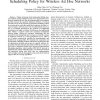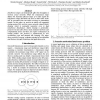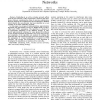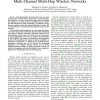669 search results - page 62 / 134 » Minimizing interference in ad hoc and sensor networks |
GLOBECOM
2007
IEEE
14 years 3 months ago
2007
IEEE
— 1 Taking advantage of the independent fading channel conditions among multiple wireless users, opportunistic transmissions schedule the user with the instantaneously best condi...
SAINT
2008
IEEE
14 years 3 months ago
2008
IEEE
Interference ranges can dramatically affect the throughput in wireless sensor networks. While the transmission range defines the maximum physical range of a radio signal the inter...
ICC
2008
IEEE
14 years 3 months ago
2008
IEEE
— Scheduling in an ad hoc wireless network suffers from the non-convexity of the cost function, caused by the interference between communication links. In previous optimization t...
ICC
2009
IEEE
13 years 6 months ago
2009
IEEE
Typically, topology control is perceived as a per-node transmit power control process that achieves certain networklevel objectives. We take an alternative approach of controlling ...
IWDC
2005
Springer
14 years 2 months ago
2005
Springer
For a connected graph, representing a sensor network, distributed algorithms for the Set Covering Problem can be employed to construct reasonably small subsets of the nodes, calle...




